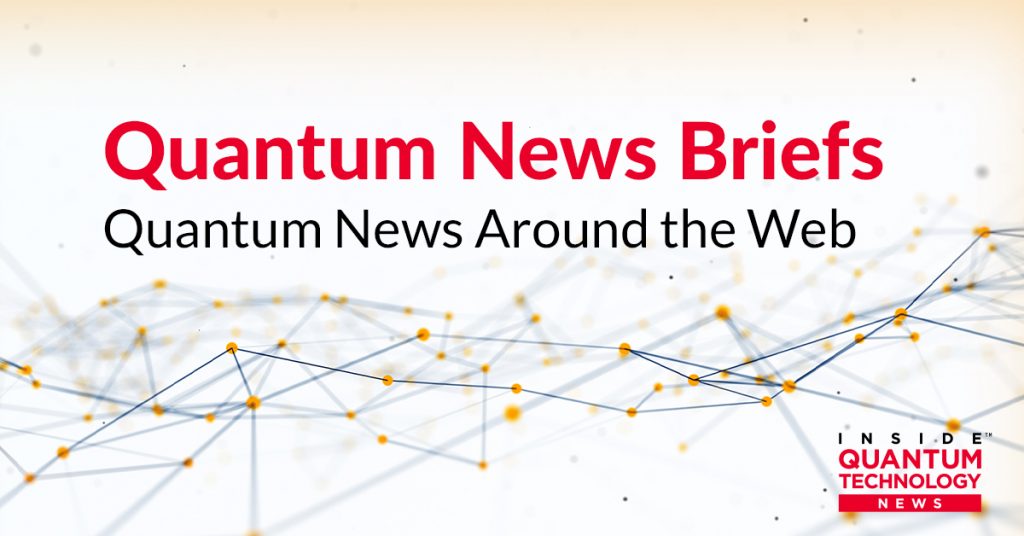Quantum News Briefs opens today with coverage from the US Senate where senators have introduced a cybersecurity bill to improve the Federal government’s defenses against quantum computing followed by a summary of an indepth article discussing the NSA’s efforts toward a quantum-resilient future. An announcement from the Korean Institute of Technology about its experimental demonstration of the TF QKD network–the second in the world after the University of Toronto in Canada and MORE
Senators Introduce Cybersecurity Bill Aimed at Improving the Federal Government’s Defenses Against Quantum Computing
Senators on July 21 introduced a cybersecurity bill aimed at improving the federal government’s defenses against data breaches enabled by quantum computing.The Quantum Computing Cybersecurity Preparedness Act, co-sponsored by Sens. Rob Portman (R-Ohio) and Maggie Hassan (D-N.H.), would require federal agencies to have the most up-to-date cybersecurity protections as quantum computers become highly advanced and widely available.
The Quantum Computing Cybersecurity Preparedness Act, co-sponsored by Sens. Rob Portman (R-Ohio) and Maggie Hassan (D-N.H.), would require federal agencies to have the most up-to-date cybersecurity protections as quantum computers become highly advanced and widely available. The bill follows two directives aimed at advancing quantum technologies that President Biden unveiled in May.
The bipartisan bill would require the Office of Management and Budget (OMB) to create guidance for federal agencies to assess critical systems a year after the National Institute of Standards and Technology (NIST) issues its planned post-quantum cryptography standards.
The legislation would also direct the OMB to send an annual report to Congress that includes a strategy on how to tackle post-quantum cryptography risk, funding and an analysis on how federal agencies are coordinating and migrating to post-quantum cryptography standards.
*****
How the NSA Is Moving Toward a Quantum-Resilient Future
This announcement was the first time that the NSA publicly recognized that quantum computing posed a serious threat to encryption and, more importantly, that it was time to act. It’s also important to note that the NSA seeks a cost-effective solution. This will undoubtedly be a key obstacle for organizations across the government and private sectors during the transition to Post-Quantum Cryptography (PQC). The NSA has deferred to the National Institute of Standards Technology (NIST) to research PQC solutions and finalize a set of quantum-resilient algorithms for use in NSS. The cost-effectiveness of this approach will largely depend on each organization’s ability to implement the new algorithms with minimal disruption to existing systems.
The NSA has stated that implementing QKD on NSS would require significant resourcing, and it did not qualify as a comprehensive quantum security solution. According to the NSA, QKD “only addresses some security threats and it requires significant engineering modifications to NSS communications systems. NSA does not consider QKD a practical security solution for protecting national security information.” The complexity of QKD undermines the goal of the NSA to provide cost-effective quantum cybersecurity as stated in the 2015 announcement. The NSA and NIST have both endorsed PQC as the superior and cost-effective quantum-resilient solution and, ultimately, PQC will become the standard for data encryption in both the government and private sectors.
The timeline for the NSA’s effort to transition to PQC was shortened significantly when in January President Biden signed a National Security Memorandum (NSM-8) on “Improving the Cybersecurity of National Security, Department of Defense, and Intelligence Community Systems.” The NSA can no longer wait until 2024 for NIST to finalize PQC standards and is now tasked with auditing the current NSS cyber infrastructure and providing a PQC transition plan immediately. This mandate marked the beginning of the biggest upcycle in cybersecurity history for the DoD.
*****
Korean Researchers Create Key Technology for Quantum Cryptography Commercialization
The Korea Institute of Science and Technology (KIST, Director Seok-jin Yoon) announced that their research team, the Center for Quantum Information, led by director Sang-Wook Han, succeeded in an experimental demonstration of a practical TF QKD network. This is the second experimental demonstration of the TF QKD network in the world after the University of Toronto in Canada.
In their study published in npj Quantum Information, the research team proposed a new TF QKD network structure scalable to a two-to-many (2:N) network based on polarization-, time-, and wavelength-division multiplexing. Unlike the first demonstration of the University of Toronto based on a ring network structure, the research team’s architecture is based on a star network. The quantum signal in a ring structure must pass through every user connected to the ring, however, the star structure only has it go through the center, making it possible to implement a more practical QKD system.
*****
Quantum Digits Unlock More Computational Power with Fewer Quantum Particles
Although storing information in zeros and ones is not the most efficient way of doing calculations, it is the simplest way. Simple often also means reliable and robust to errors and so binary information has become the unchallenged standard for classical computers.
In the quantum world, the situation is quite different. In the Innsbruck quantum computer, for example, information is stored in individual trapped Calcium atoms. Each of these atoms naturally has eight different states, of which typically only two are used to store information. Indeed, almost all existing quantum computers have access to more quantum states than they use for computation. Complete release on Science Daily.
*****
